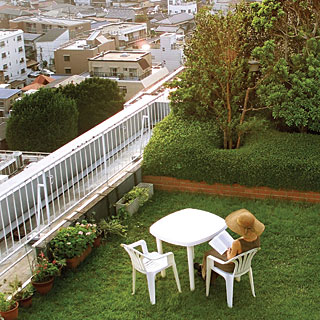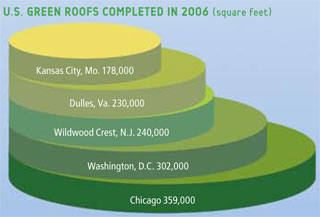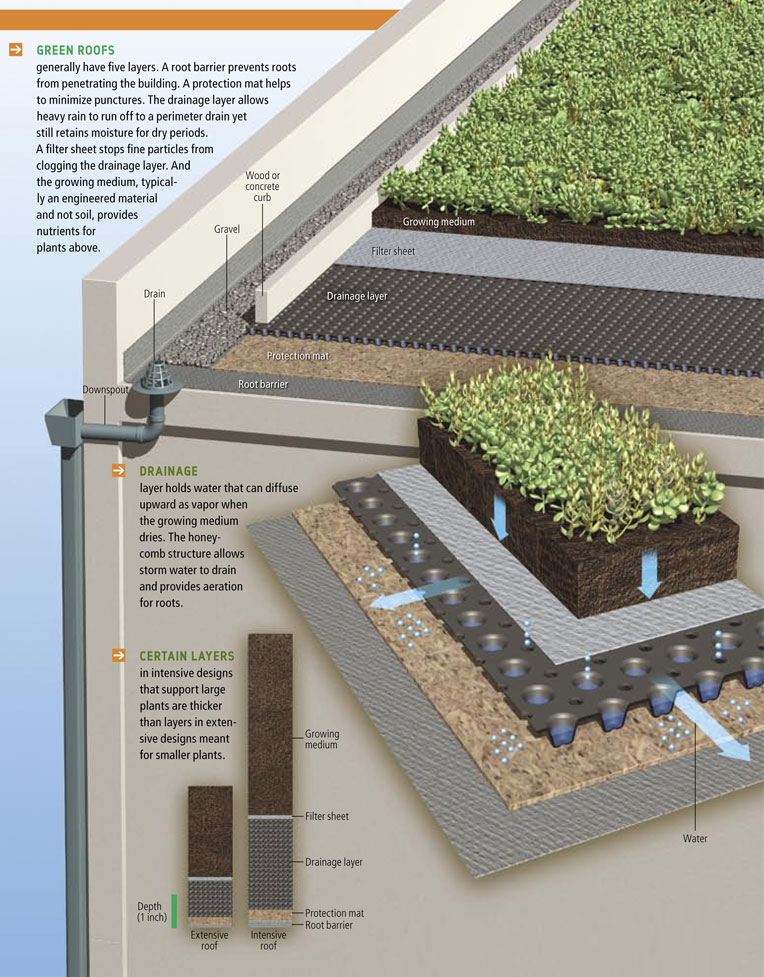Cities worldwide are promoting
environmentally "green" roofs to mitigate several urban problems. Ground
cover, shrubs and other flora planted across a building's roof can reduce
storm water runoff, easing the burden on local sewers and water treatment
systems. And the vegetation can keep the roof cooler in summer, lowering
interior air-conditioning costs and therefore peak demand on area power
plants.
Green roofs have been blossoming in Europe
for more than a decade, and Tokyo now requires that at least 20% of any
new roof on medium and large buildings be cultivated. Chicago is the U.S.
leader. Most installations are made on newly constructed buildings, but
retrofits are rising.
In either case, the formations are built up
in a series of layers that span all or part of a roof. So-called extensive
roofs have fairly thin cross sections, including perhaps three inches of
soil-like growing material; they weigh from 15 to 25 pounds per square
foot when saturated and support low-lying plants. Intensive roofs are thicker,
heavier and more costly to erect and maintain but are capable of supporting
flowerbeds, shrubs, even trees. "As the plants get more demanding, the
layers must become more robust, with better drainage and aeration,"
says Jeff Stillman, executive vice president of ZinCo USA in Newton, Mass.,
a division of ZinCo, Inc., the world's largest supplier of green roof components.
Prefabricated modules of a few feet square
that contain similar layers can also be assembled like puzzle pieces; this
approach can be easier to install, although it can be expensive and also
results in seams.
The main drawback of all the approaches is
cost. Some roofs—typically older ones—may not be strong enough to handle
the weight. Standard insurance policies may construe a green roof as a
structure that can create "standing water" damage, which a policy probably
will not cover unless it is amended. Extensive roofs typically require
minimal maintenance and an occasional dose of slow-release fertilizer;
intensive roofs require more ongoing attention. Both styles, however, can
turn a hot, bald roof into a pleasant space for coffee breaks, lunch, sunbathing
or a simple breath of fresh air.
Did You Know...
NOT DIRT:?
Installers rarely use soil for the growing
medium because it is heavy and because it packs tight after repeated rains,
reducing water retention and aeration for plant roots. They instead use
manufactured materials. For example, granulated clay or shale may be heated
until it forms air pockets; it is then cooled. Organic compost and fertilizer
are added as nutrients.
COOLER CONDITIONING:?
On a sunny, 80-degree-Fahrenheit day, a tar
or black-painted roof can reach 180 degrees F; a white roof 120 degrees;
and a plant-covered roof 85 degrees. Even if the building has ample roof
insulation to retard interior heating, the intake vents for air-conditioning
units are often located on the roof. Cooler incoming air lessens the system's
burden, notes Jeff Stillman of ZinCo USA. |
HEAT ISLAND EFFECT:?
If installed widely, green roofs could lower
a city's cooling load, especially at night when bare rooftops radiate heat
absorbed during the day. Since 1900 Tokyo's average temperature increase
has been five times that of global warming, according to Tokyo Metropolitan
University—one big reason the city is pushing such construction.
SEDUM PREFERED:?
Plants most recommended for green roofs belong
to the genus Sedum. They grow low, store plentiful water in their leaves,
and are bred to withstand temperature and moisture extremes. Common varieties
include cape blanco, coral carpet and dragon's blood.

Rooftop garden overlooks residential Tokyo.

SOURCE FOR ROOF DATA: GREEN ROOFS FOR HEALTHY CITIES

GREEN ROOFS generally have five layers. A root barrier prevents roots
from penetrating the building. A protection mat helps to minimize punctures.
The drainage layer allows heavy rain to run off to a perimeter drain yet
still retains moisture for dry periods. A filter sheet stops fine particles
from clogging the drainage layer. And the growing medium, typically an
engineered material and not soil, provides nutrients for plants above. |